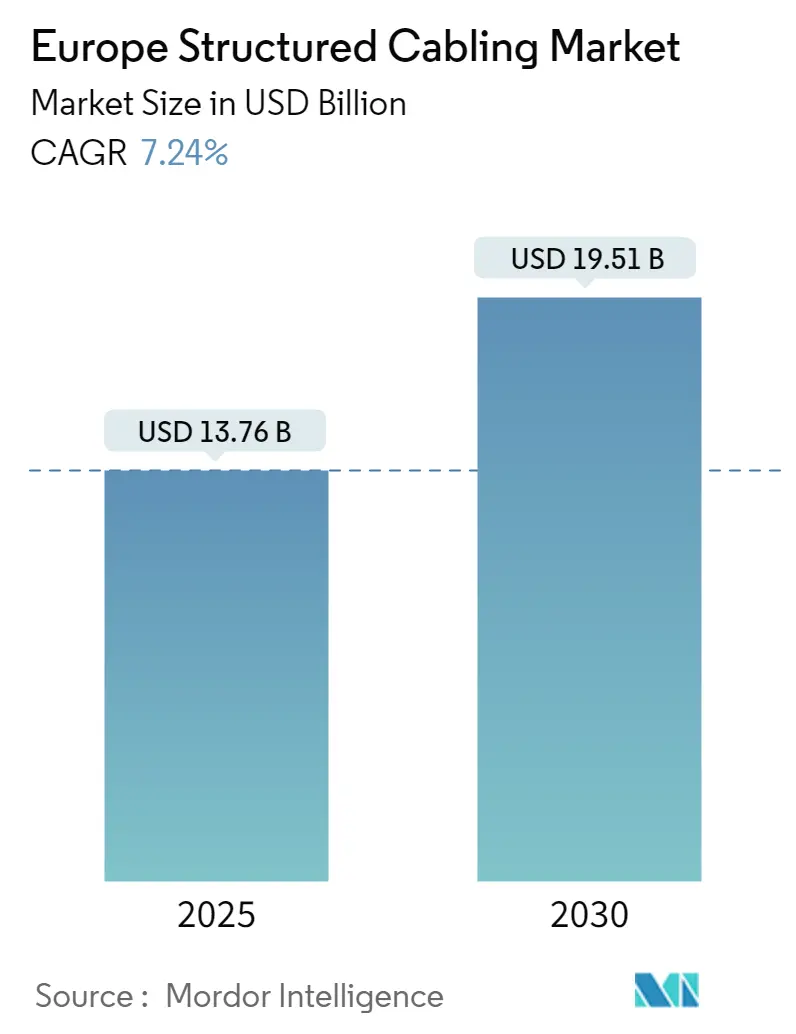
| Study Period | 2019 - 2030 |
| Base Year For Estimation | 2024 |
| Forecast Data Period | 2025 - 2030 |
| Market Size (2025) | USD 13.76 Billion |
| Market Size (2030) | USD 19.51 Billion |
| CAGR (2025 - 2030) | 7.24 % |
| Market Concentration | High |
Major Players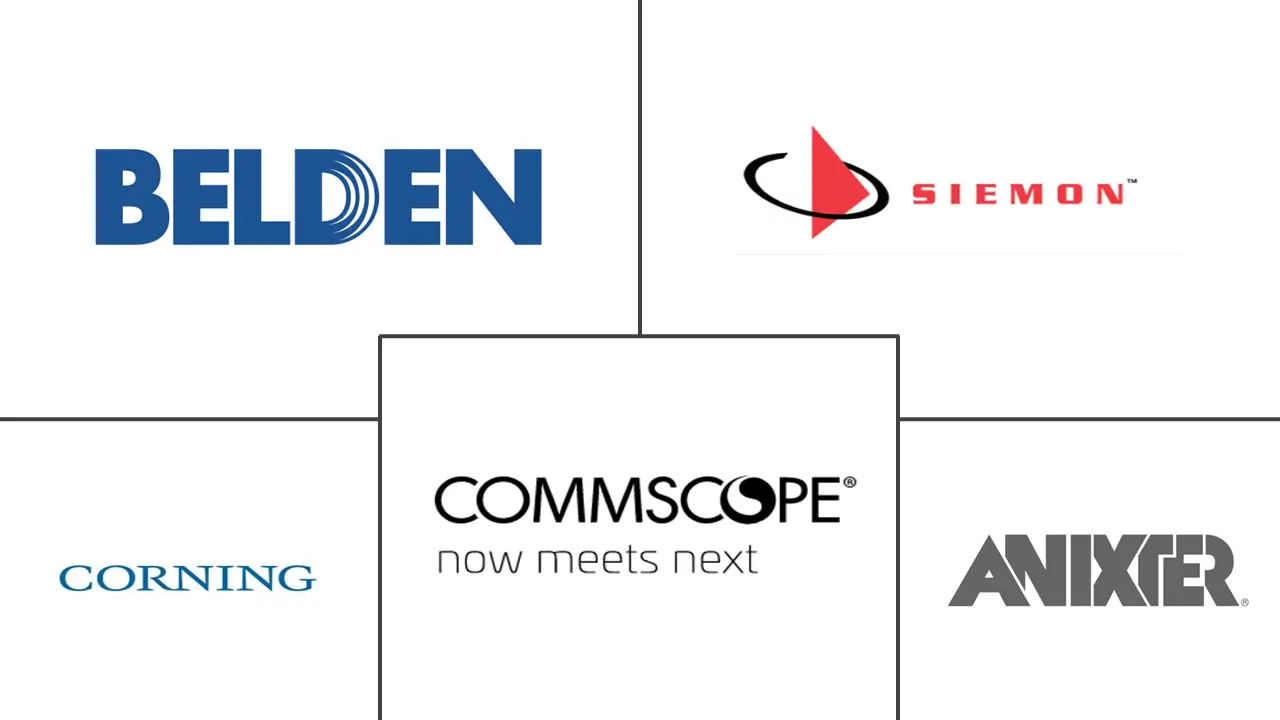
*Disclaimer: Major Players sorted in no particular order |
Europe Structured Cabling Market Analysis
The Europe Structured Cabling Market size is estimated at USD 13.76 billion in 2025, and is expected to reach USD 19.51 billion by 2030, at a CAGR of 7.24% during the forecast period (2025-2030).
The increasing demand for connected IoT devices, growing investment in data centers and communication infrastructure, and the increasing acceptance of cloud services across various end-user industries are among the key factors driving the studied market growth.
- Structured cabling is the foundation upon which all other network equipment operates and is dependent. A reliable cable infrastructure is needed to convey information efficiently over a structured network. Doing this makes it possible to guarantee the efficient handling of all crucial corporate operations, communications, and processes. By fusing telephone networks, security, local computers, and other technologies, structured cabling provides a broad environment for data transmission.
- The high bandwidth of a structured cabling system is one of its most essential features, making it a dependable framework for fostering business expansion. Adaptable IT that can react rapidly to industry developments is crucial in a competitive company environment. The need for a data center that facilitates the quick and simple creation of new services helps organizations keep current customers and continually attract new ones. The network architecture will be updated with structured cabling and handle all new applications as the company expands.
- The European region's need for data storage is increasing due to the growing adoption of cloud services and connected devices, supporting the demand for structured cabling. Also, the market for structured cabling is growing because more and more businesses in the area are using cloud computing solutions.
- The massive growth of Internet users and smart mobile communication devices drives strong demand for data center services as the amount of data generated by these devices surges. This is attracting new players in the European data center market. For instance, in August 2022, Damac Group announced it was looking into data center and technology-related investment opportunities in Germany worth EUR 1 billion (USD 991 million) to diversify its holdings.
- Similarly, in May 2022, Google launched Madrid-based cloud data centers to expand its European footprint. The new venture will allow Madrid's various businesses to increase cloud services, low-latency transfers, advanced storage, and computing, allotting the region a necessary boost in data protection and over-the-air enterprise needs. Since data centers often use integrated cabling systems, these trends will likely increase the demand for structured cabling.
- However, the high data transmission loss of fiber optic components and the high cost of fiber optic components are among the major factors restraining the growth of the structured cabling market in the region.
- All businesses across Europe with crucial assets have experienced a rapid decline due to the pandemic. The COVID-19 pandemic stressed Europe's overall economy across sectors and steered multiple international vendors to focus on the digital economy. Different European companies invested more in cloud infrastructure and trusted computing resources to help businesses speed up the recovery process and offer cloud-based intelligent solutions to help them with their digital transformation in the wake of the pandemic. This created a good market environment for the growth of the studied market.
Europe Structured Cabling Market Trends
Datacenter to Hold Significant Market Share
- Data centers are both the powerhouses of cloud computing and the connectors of the internet, delivering on the tripartite need for more speed, flexibility, and optimal availability. Two key drivers catalyzing the massive demand increase for data centers in the European region include the need for computing capacity, driven by the large-scale move to working from home for many businesses and institutions, and the associated uptake of digital applications in video calling, telehealth, e-commerce, and e-learning, which cause a surge in need for data capacities.
- Edge computing will play a massive role in the development of future data centers. As more and more people adopt intelligent solutions, not only in companies but also in their homes, the demand for edge computing will continue to boom, as will the need for edge computing devices. This factor and increasing research and development investments in the edge computing sector are expected to positively impact the studied market's growth. For instance, in July 2022, a new cluster of meta-operating systems research and innovation actions received EUR 64 million (about USD 68.08 million) of EU funding to revolutionize edge computing in Europe.
- UK and US investment firms recently collaborated to build a hyperscale data center. Pioneer Point (UK) and Davidson Kempner (US) plan a 450 MW data center campus in Portugal. Two funds will invest up to EUR 3.5 billion (USD 4.21 billion) in the Sine 4.0 project. The new multi-billion-dollar hyperscale data center campus will consist of five 90-MW sea-water-cooled buildings on land near a recently decommissioned coal power plant. The inauguration of the primary building is scheduled for the end of 2023. Sines 4.0 is a large-scale, 1005-green data center that responds instantly to customer needs.
- Furthermore, as the environmental demands placed on data center providers continue to become more restrictive, Increased attention is being focused on full lifecycle impacts, including construction, recycling, and end-of-life. Data center operators are increasingly focusing on adopting innovative solutions and techniques to drive operational efficiency in order to meet sustainability targets. With such trends expected to continue during the forecast period, the studied market is also expected to witness an upward growth trend during the forecast period.
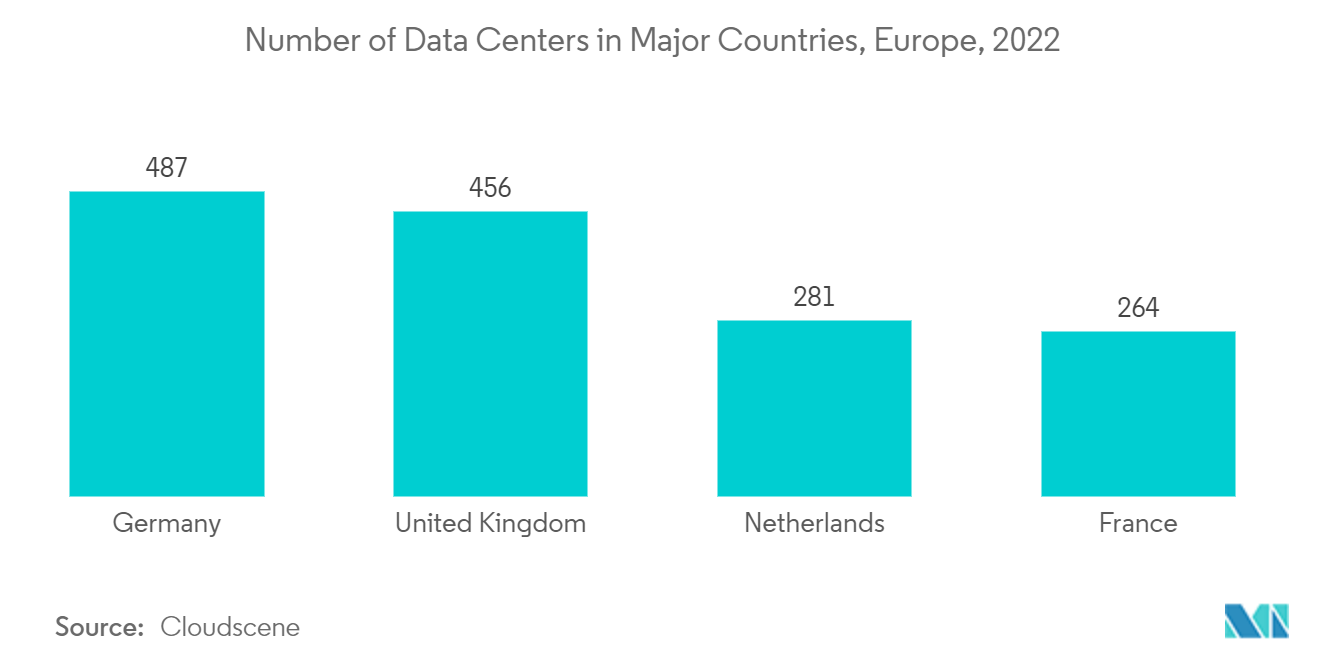
United Kingdom to Witness Significant Growth
- The rapid proliferation of digital services and the growing number of Internet users have exponentially increased the amount of sensitive data collected by businesses in the United Kingdom. For instance, according to Hootsuite, as of January 2022, the United Kingdom had approximately 67 million internet users in total.
- Due to the growing demand, multiple companies offering cloud services have established extensive data center locations in the country, driving the demand for structured cabling. For instance, according to a recent survey by OpenUK, about 68% of respondents in the United Kingdom use Amazon Web Services (AWS) for their cloud infrastructure, followed by Google (49%), Microsoft Azure (47%), and others.
- The growth of the structured cabling market in the United Kingdom is also accelerating due to the increasing construction of hyperscale data centers to store huge amounts of data in the United Kingdom. For example, in February 2022, NTT said it planned to double the size of its data center in London. This was part of the company's ongoing plans to invest in the UK and help speed up digital transformation and a hybrid IT environment.
- As structured cable systems enable faster data transmission, such trends are expected to support the studied market's growth in the United Kingdom during the forecast period. Furthermore, the increasing focus on cost and time management, the growth of IoT data, and the need for business automation are also significantly contributing to the growth of the demand for the structured cabling market in the country.
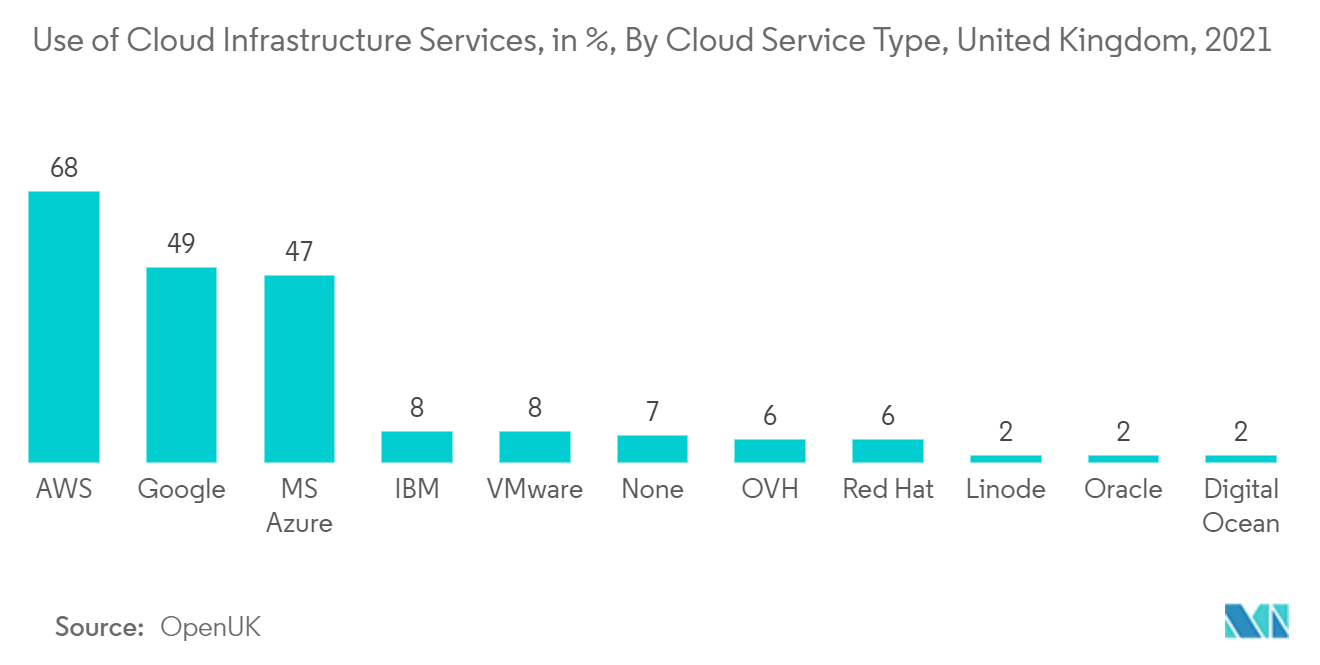
Europe Structured Cabling Industry Overview
Europe's Structured Cabling Market is fragmented due to several players' presence. Major players are adopting various strategies, such as new product launches, joint ventures, partnerships, collaborations, partnerships, and acquisitions, to increase their footprints in this market and sustain it in the long run. Some key players in the market are Belden Inc., The Siemon Company, Corning Incorporated, Commscope, Inc., Anixter, Inc., and many more.
- April 2024 - euNetworks Group Limited, a Western European bandwidth infrastructure company, expanded its Pan-European network by introducing a new duct and fiber-based network in Brussels. With this enhancement, the company now boasts 18 owned and operated metropolitan networks across Europe.
- September 2023 - HFCL Limited, a technology enterprise, has introduced its Intermittently Bonded Ribbon (IBR) cables in the United Kingdom (UK) as a strategic step in its global expansion. These cables, each housing individual Intermittently Bonded Ribbons, facilitate a denser fiber packing in narrow ducts. This feature proves especially advantageous in densely populated regions where space is a premium. The initiative targets the UK's urban and rural areas, aiming to combat the prevalent broadband access issues and expedite the adoption of 5G and FTTP technologies.
Europe Structured Cabling Market Leaders
-
Belden Inc.
-
The Siemon Company
-
Corning Incorporated
-
Commscope, Inc.
-
Anixter Inc
- *Disclaimer: Major Players sorted in no particular order
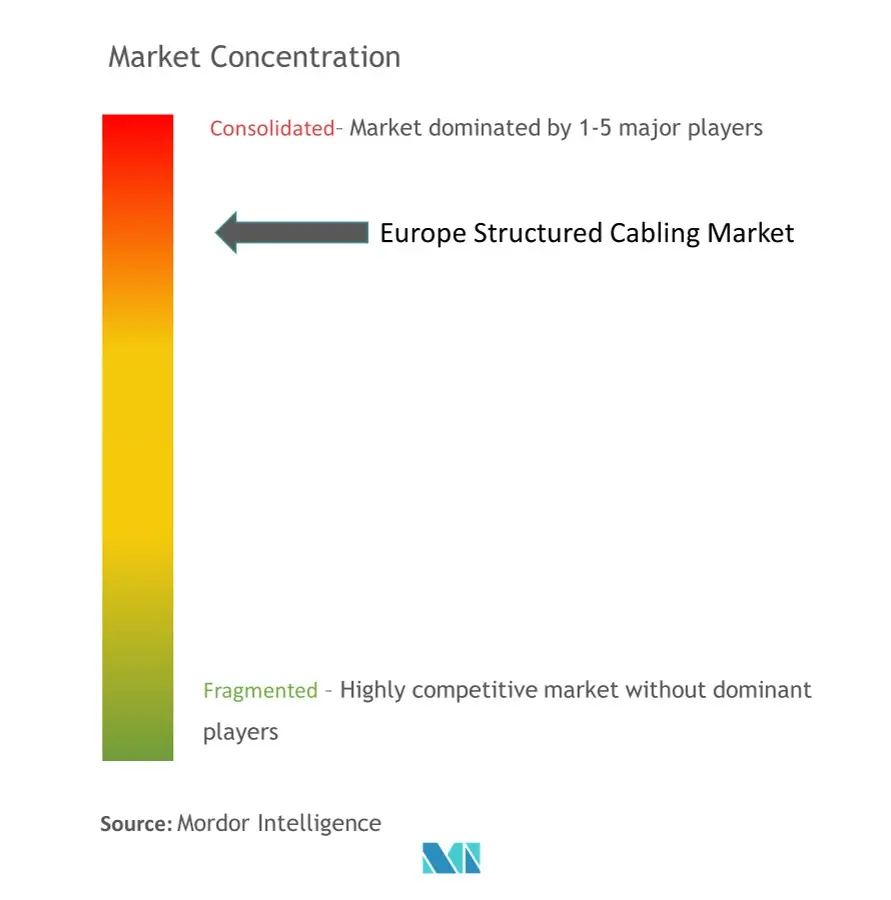
Europe Structured Cabling Market News
- November 2023 - GÉANT has signed a EUR 40 million deal with the European Commission, the European Investment Bank, and AFR-IX Telecom for the MEDUSA submarine cable initiative, aimed at enhancing trans-Mediterranean research and education connectivity.
- November 2023 - Metrofibre, a provider of urban fiber optic networks, intensified its expansion efforts by securing a collaboration with the city of Mulheim an der Ruhr in North Rhine-Westfalia, Germany. Metrofibre's project, dubbed "ruhrfibre Mulheim," aims to connect approximately 70,000 households to a high-speed grid by 2027.
Europe Structured Cabling Industry Segmentation
Structured cabling is a uniform structure plan for a future-oriented and application-independent network infrastructure on which different services (voice or data) are transmitted. This step avoids expensive, incorrect installations and expansions and facilitates the installation of new network components.
Europe's Structured Cabling Market study provides a detailed insight into the market's current trends and emerging opportunities. The study segments the market by Product Type (Copper (Copper Cable, Copper Connectivity), Fiber (Fiber Cable (Single-mode & Multi-mode), Fiber Connectivity)), by Application (LAN, Datacenter), and by Country. The market sizes and forecasts are provided in terms of value in USD for all the above segments.
| By Product Type | Copper | Copper Cable | |
| Copper Connectivity | |||
| Fiber | Fiber Cable (Single-mode & Multi-mode) | ||
| Fiber Connectivity | |||
| By Application | LAN | ||
| Datacenter | |||
| By Country | Europe | United Kingdom | |
| Germany | |||
| France | |||
Europe Structured Cabling Market Research FAQs
How big is the Europe Structured Cabling Market?
The Europe Structured Cabling Market size is expected to reach USD 13.76 billion in 2025 and grow at a CAGR of 7.24% to reach USD 19.51 billion by 2030.
What is the current Europe Structured Cabling Market size?
In 2025, the Europe Structured Cabling Market size is expected to reach USD 13.76 billion.
Who are the key players in Europe Structured Cabling Market?
Belden Inc., The Siemon Company, Corning Incorporated, Commscope, Inc. and Anixter Inc are the major companies operating in the Europe Structured Cabling Market.
What years does this Europe Structured Cabling Market cover, and what was the market size in 2024?
In 2024, the Europe Structured Cabling Market size was estimated at USD 12.76 billion. The report covers the Europe Structured Cabling Market historical market size for years: 2019, 2020, 2021, 2022, 2023 and 2024. The report also forecasts the Europe Structured Cabling Market size for years: 2025, 2026, 2027, 2028, 2029 and 2030.
Our Best Selling Reports
Europe Structured Cabling Industry Report
Statistics for the 2025 Europe Structured Cabling market share, size and revenue growth rate, created by Mordor Intelligence™ Industry Reports. Europe Structured Cabling analysis includes a market forecast outlook for 2025 to 2030 and historical overview. Get a sample of this industry analysis as a free report PDF download.




